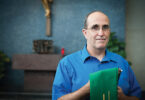
Leon Suprenant is the pastoral associate for administration in the office of the permanent diaconate. He also blogs at: www.archkck.org/blog.
by Leon Suprenant
One of my favorite images of the deacon is that of herald, or messenger.
In the rite of ordination to the diaconate, the bishop says to the new deacon, “Receive the Gospel of Christ, whose herald you have become.” In artistic depictions of the Annunciation, the Archangel Gabriel is often depicted wearing a dalmatic, the vestment of a deacon, so as to symbolize his role as herald of the coming of the Christ Child.
The role of the deacon as herald of the Gospel of Christ is especially evident in the Easter Vigil liturgy, the greatest feast of the church. He brings the lighted paschal candle into the darkened church, stopping three times, proclaiming “The Light of Christ.” Then the deacon proceeds to the ambo, where he then sings the Exsultet, a long, magnificent proclamation of the resurrection of Christ.
I should back up at this point and note that the priest or even a lay cantor may sing the Exsultet, but the Roman Missal itself notes that the proper and preferred minister to sing the Exsultet is the deacon.
Why would this be? The reason is that the Exsultet is nothing less than the proclamation of the Gospel, and the deacon is ordained to be a herald, or messenger, of this good news. Just as the faithful stand to hear the priest or deacon proclaim the Gospel at Mass, all the faithful at the Easter Vigil stand during the Exsultet.
And the deacon is dressed in white, recalling the angel at the empty tomb: “His appearance was like lightning and his clothing was white as snow” (Mt 28:5).
The Exsultet, or Easter Proclamation, dates all the way back to the fourth century. The version now in use probably originated in the fifth century. The use of the paschal candle goes back even further and is rooted in ancient Jewish customs. It is a jewel of our Catholic tradition and a call to joyful praise and jubilation.
The Exsultet is a compendium of salvation history. Christ is presented as the true lamb of God who takes away the sins of the world, the one who delivers us not from slavery in Egypt but from slavery to sin, and the true light that overcomes our darkness.
Perhaps the most famous line from the Exsultet is its reference to original sin:
“O truly necessary sin of Adam, destroyed completely by the Death of Christ!
“O happy fault that earned so great, so glorious a Redeemer!”
During these final weeks leading up to Easter, let us reflect on what these words mean for us — that the redemption Christ offers us is even greater than our sins. As St. Paul wrote: “Where sin increased, grace abound- ed all the more” (Rom 5:20).

